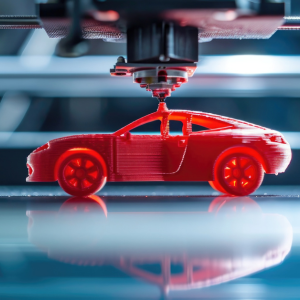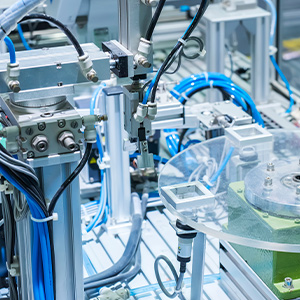3D Printing vs CNC for Rapid Prototyping
Post By: Ryan King On: 15-06-2023 - Industry 4.0 - Industry Trends - Manufacturing
Regarding rapid prototyping, there's a straight choice between 3D printing and CNC (Computerised Numerical Control) machining – but which one is right for you?
To make the right choice, you first need to understand the differences between the two technologies and how they compare according to what you're trying to accomplish:
- 3D printing works by adding layers, or slices, of material to form solid objects, as a CAD (Computer Aided Design) file directs.
- CNC machining also relies upon CAD for its instructions, but that's where the similarity ends. CNC manufacturing involves painstakingly removing material from an initial 'blank' to arrive at the desired outcome – aided by programmed toolpaths that use a range of precision cutting tools, including laser cutters, lathes, and grinders.
Rapid Prototyping
Rapid prototyping demands through the life cycle of product development often include initial mock-ups, sample parts and scale models. These can be rapidly assembled for rigorous testing across various metrics, including durability, size, and shape.
Additive technology – 3D printing – is often regarded as the 'go-to' technology for rapid prototyping, although this will vary on a case-by-case basis.
There is no one-size-fits-all solution when choosing between 3D printing and CNC machining for rapid prototyping. To make a decision, you need to look at the following variables:

Accuracy and Repeatability
Rapid prototyping demands an 'accurate-as-possible' representation of what the user is attempting to create, either as a standalone product or an individual part of a more significant innovation.
CNC machining is regarded as being the more accurate of the two technologies, including being able to 'finish off' products initially created using 3D printing. But this will depend on the material being used.
Repeatability – producing a product at scale instead of in smaller volumes – usually becomes a consideration once the prototyping stage has passed into total production. The rigid framing typical of CNC machinery ensures fewer vibrations, resulting in more consistent finishes. On the other hand, the continual layering of material in 3D printing can result in occasional inaccuracies.
Speed
Rapid prototyping demands a quick solution to develop a better understanding of parts within a larger product. It enables developers to arrive quickly at their conclusions, but a perceived lack of achievable detail within a narrow timeframe could be a downside.
Again, much will depend on individual demands, such as initial intricacy, whether personal or multi-part production is required, and the size of the piece being produced.
CNC machines are considered to be quicker at cutting or forming shapes than 3D printers, as well as being the better option for more oversized items.
Range of Materials
This, again, depends on the demands of the overall project. Thermoplastics and thermosets are frequently used in 3D printing. While some metals, wax, and ceramics can also be used in additive manufacturing (AM) additive manufacturing (AM), CNC is more versatile. It can handle a more comprehensive range of materials, including a broader array of metals. However, some exotic alloys necessitate specialist tooling that might be beyond the ability of conventional CNC operators.
Financial Cost
This, again, depends on the individual's case. The type of material used – and whether prototypes are being created in-house or by a contractor – are major economic factors; the cost of skilled/knowledgeable labour and purchasing and maintaining the necessary machinery must be considered.
Finish, quality and compatibility with other components
Much depends on the appropriate tooling to achieve the desired finish and the material used. 3D printing of layering material may require hand-finishing before final refinement. CNC machining uses a minimum of three axes – vertical, horizontal and depth – to achieve the desired shape.
Many projects will demand components that smoothly interface with the broader product in which they will be used, with CNC technology arguably better placed to achieve this.
Waste And The Environment
Manufacturing processes produce physical waste during production and in the packaging of the finished product. Correctly disposing of or recycling waste is essential for an organisation's 'green' credentials and can impact the overall unit cost.
In theory, 3D printing creates less waste than the accepted CNC practice of cutting away a blank/block, but the former predominantly uses plastics. At the same time, CNC works with a far more incredible array of materials, many of which are more sustainable. This alone does not automatically equate to environmental soundness, but plastic waste is an environmental issue best dealt with by using (and producing) less of it.
Durability and Tolerance
Much depends on the material being used. However, the basic premise of layering additive material fused (3D printing) against one that subtracts from an original building block (CNC) would suggest the latter has greater strength – but that's not always true. The cutting away of some materials could fundamentally weaken the structure.
Generally speaking. However, it can be assumed that a tighter tolerance is achieved from working with an individual block of material rather than one created by layering.
Individual Project Considerations
From all this, it can be concluded that many factors make it challenging to set 3D printing apart from CNC machining for rapid prototyping. Much depends on the individual project, with the desired material chosen for strength and tolerance determining which technology will be best. Also, remember that suitability for use during initial prototyping may not go hand in hand with ultimately producing at scale for the commercial market.
Considerations such as sustainability and environmental impact are increasingly becoming more relevant, with both technologies arguing cases for and against their use within a 'green' remit.
CNC machining can involve potentially costly skilled labour, mitigated by the broader range of materials it can work with.
There will be some occasions where either discipline can be harnessed, but in most scenarios, it should be evident whether 3D printing or CNC machining will be the best choice for the project you have in mind.
Get More From Rowse Straight To Your Inbox




